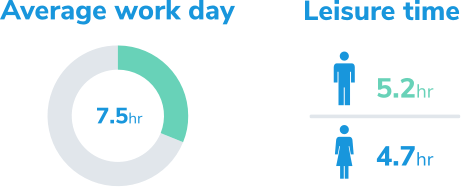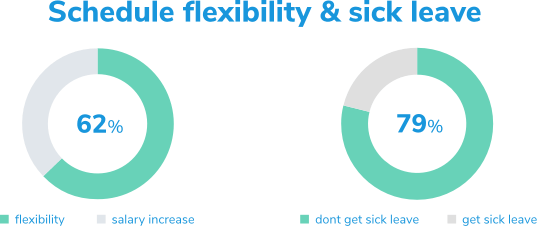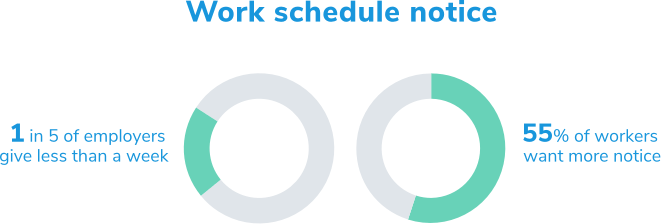The Ultimate List of Time and Attendance Statistics
Select a category to see the results
How does your workday compare to everyone else’s? Curious to know who gets the most time off? Want to know if a time tracking or scheduling app could save you money? You’re in luck. You can get all of the answers to these and many other work-related questions right here.
Time tracking
The average American workday is less than eight hours long
On average, US workers typically work 7.5 hours a day. Outside of working hours, men get 5.2 hours of leisure time, on average. For women, the average is 4.7 hours of leisure time. 1
More than 1 in 3 time tracking systems is outdated

Only 25 percent of US employees2 and just 14 percent of Canadian employees3 who track time use mobile apps. In the US, 38 percent use manual systems like punch cards ,paper timesheets and time cards. In Canada, 58 percent still track time using manual punch cards and timesheets, etc.3
80 percent of employee timesheets have to be corrected
US employers say they have to correct errors on 80 percent of the timesheets their employees submit.5 The reason? Employees reveal it’s because they can’t remember their hours when they forget to clock in or out.1
Time tracking isn’t just for hourly employees
Only 66 percent of US workers2 and 54 percent of Canadian workers3 who track their time are paid by the hour. The rest are salaried, self-employed, or business owners.

People who track their time like to be organized.
Almost two-thirds (62 percent) of US workers2 and 96 percent of Canadian workers3 who track their time categorize it by job, task, project, client, or miles traveled.
Most American workers are happy to track their time.
Almost all (95 percent) of US workers who track their time say they are happy to do it. Three-quarters agree “it is very important and I try to be as accurate as I can.”2
Most timesheets are submitted daily or weekly
In the US, the monthly timesheet is a rare beast. Most people — 67 percent, to be exact — submit their timesheets daily or weekly, while 22 percent submit timesheets twice a month.2
Save time and money with QuickBooks Time
On average, businesses that use QuickBooks Time save 6 percent on gross payroll costs, reduce the time it takes to run payroll by three hours, and increase the amount of billable time they put on their invoices by 11 percent.5
Wage theft and time theft
Wage theft costs US employees $22 billion a year
Almost 10 percent of US business owners admit to taking time off employee timesheets after they have been submitted. This costs each worker between $1,400 and $6,000 a year. Nationally, that’s equivalent to around $22 billion. This is why tracking attendance is very important. It can be tracked back to savings for large and small business.
Time theft costs US employers $11 billion a year
Almost half (49 percent) of US employees2 and 62 percent of Canadian employees3 who track time admit to time theft. In the US, this costs employers more than $11 billion a year.

Buddy punching costs US employers $373 million a year
Sixteen percent of US employees2 and 34 percent of Canadian employees3 who track time admit to buddy punching. In the US, this costs employers at least $373 million a year.
Time theft is widespread
Accountants say 92 percent of their clients have a problem with time theft — adding 5 percent, on average, to their gross payroll costs.7
Labor law compliance
43 percent of US business owners don’t know what the FLSA is
The Fair Labor Standards Act was passed in 1938 to protect workers with a standard 40-hour workweek and a minimum wage — but 43 percent of US business owners are unaware of the legislation.8
FLSA lawsuits have risen by 417 percent since 1997
The worst-hit businesses in the US are restaurants, hotels, health care providers, construction companies, and clothing manufacturers.9

The total cost of FLSA violations since 1984 is $2 billion
The total amount of back wages and fines recovered by the US Department of Labor for minimum wage and overtime violations under the FLSA amounts to $2,075,786,993.9
Most FLSA prosecutions start with overtime violations
Over three-quarters (83 percent) of all of the money recovered by the US Department of Labor from US employers comes from overtime violations. Since 1984, this has cost businesses $1,717,270,795.9

Most businesses suck at record-keeping
Only 16 percent of US business owners know timesheets have to be kept for two years. Roughly 1 in 3 (36 percent) of US business owners are aware that payroll records have to be kept for three years.10
Off-the-clock work is common
Almost a third (28 percent) of US employees who track time admit to working off the clock — a major cause of wage theft and FLSA lawsuits.2
A third of US businesses are breaking the law on comp time
One in 3 private-sector employers in the US uses compensatory time (also known as “time off in lieu”) instead of paying overtime to employees — a common violation of the FLSA.11
Productivity
Your smartphone is making you less productive
Smartphone users are four times more likely to be distracted by their phone at work than non-smartphone users. Just 10 percent of flip phone users admit to it being a distraction compared to 40 percent of people who use a smartphone.12
36 percent of March Madness fans watch games at their desks
One in 5 US employees works fewer hours during the March Madness basketball tournament. But the majority (about 70 percent) don’t believe it has a negative impact on their productivity. As many as 1 in 5 admits to hiding in the restroom to watch games.13
62 percent of US workers would give up a pay rise for more flexibility
Workplace flexibility is important to many US workers, with almost two-thirds saying they would give up a pay rise to have more control over the hours they work.14

Most US workers want paid sick leave but few get it
Paid sick leave is a rare benefit that US workers value highly. Many employees (85 percent) say employers should offer it but only 21 percent get it. It’s a similar story for other benefits, such as maternity and paternity leave.14
93 percent of US employees prefer face-to-face meetings over video calls
Despite vast improvements in video conferencing technology in recent years, most US employees who regularly travel for work say face-to-face meetings can’t be beaten.15
Paid time off
70 percent of US workers don’t use their paid time off.
US employers typically offer 11-15 vacation days per year but 16 percent of US employees get no paid time off at all. Of those who do get PTO, 70 percent don’t use all of it. They waste 600 million vacation days a year.14
51 percent of Canadian workers don’t use their paid time off
Canadian employers typically offer 10 vacation days per year. But up to 8 percent of Canadian employees get no paid time off at all. Of those who do get PTO, 51 percent don’t use it all. These employees usually leave at least five days unused.3
74 percent of Australian workers don’t use their paid time off
Australian employers typically offer 16-20 vacation days per year — but 14 percent of Australian employees get no paid time off at all. Of those who do get PTO, 74 percent don’t use it all. These employees usually leave at least six days unused.16

80 percent of US workers would take a pay rise over more time off
Just 1 in 5 US employees would prefer to get more time off instead of more money from their employer. The remaining 80 percent would take the money.14
65 percent of Canadian workers would take a pay rise over more time off
More than 1 in 3 Canadian employees would prefer to get more time off instead of more money from their employer. The remaining 65 percent would take the money.3
69 percent of Australian workers would take a pay rise over more time off
Less than 1 in 3 Australian employees would prefer to get more time off instead of more money from their employer. The remaining 69 percent would take the money.16
Shift work and scheduling
Employers waste a lot of time on work schedules
Only 18 percent of US employers who schedule shifts use an app to do so. On average, they spend 2.4 hours a week preparing workers’ shift schedules.17
68 percent of employee work schedules are handwritten
Almost 1 in 2 shift workers (45 percent) in the US gets their weekly work schedule on a piece of paper. One in 10 receives it via phone or text. Another 1 in 10 receives it on a spreadsheet. And 3 percent receive it on a whiteboard.17

It’s common for shift workers to miss shifts
For almost 1 in 10 businesses in the US that employs shift workers, it is a daily occurrence for workers to miss shifts. Another 18 percent say it happens several times a week. Just 2 percent say their employees never miss shifts.17
Employers lose thousands of dollars a year when employees miss shifts
Having to find last-minute replacements, close early, or pay extra to find cover adds $633 a month, on average, to employers’ operating costs. That’s equivalent to $7,594 a year.17
Shift workers struggle with last-minute schedule changes
Almost two-thirds of US shift workers have had a shift canceled at the last minute. Some 39 percent say they have been told the night before their shift was due to start, while 20 percent have been told on the way to work. Almost a third (28 percent) have been told when they arrive at work.17
Many employers share work schedules at the last minute
One in 5 US employers gives less than a week’s notice of employee work schedules. Over half (55 percent) of shift workers say they need more notice than their employer usually provides.17

Shift-working jobs have a high turnover
The No. 1 challenge faced by US business owners who employ shift workers is holding on to good employees, followed by workers missing shifts, recruitment problems, labor costs, and planning weekly shift schedules.17
Shift workers struggle with work-life balance
The No. 1 challenge faced by US shift workers is having enough time for their hobbies, followed by finding time to see friends, exercise, eat well, and get a good night’s sleep.17
Most shift workers don’t get regular breaks
Only 78 percent of US businesses that employ shift workers allow their employees to take regular breaks. Almost half (46 percent) don’t provide a rest area or lounge for employees.17
Technology in the workplace
GPS tracking is on the rise
Around 1 in 3 workers in the US, Canada, Australia, and the UK has been tracked by GPS at work. Most are more concerned about data and battery use than privacy.18
At least 1 in 10 GPS users is tracked 24-hours a day
In Australia, 11 percent of employees who use GPS tracking at work say their employer tracks them 24 hours a day. In the US, the proportion rises to 15 percent. In Canada, it rises again to 16 percent. In the UK, it’s 21 percent — more than 1 in 5.18

For many workers, privacy is not the No. 1 concern about GPS tracking
Employees in the US, Canada, and Australia are more concerned about data and battery drain than privacy when being tracked by a GPS app at work. Only British workers cite privacy as their No. 1 concern.18
Most Americans don’t know what biometric data is
Only 1 in 10 people in the US know that fingerprint scans, retina and iris scans, DNA tests, handprint geometry, and photographs of faces all contain biometric data.19